In this article, we discuss seven specialty louvers and their applications. They can provide shade, provide a restricted area, and even dampen loud noises. Louvers can do more than you think! Read more to find out what these louvers can do.
Louvers can do a lot. Their straightforward design makes them a versatile solution for many different applications. You can do a lot of things with louver blades in a frame. And in some cases, you don’t even need the frame!
Specialty Louvers
Louvers can be used to hide equipment and conceal restricted areas. They can also be mounted along a wall to accentuate the architectural features of the building. You may need a ventilation opening on the roof and a standard louver just won’t work. There are specialty louvers for all these situations, and more. Let's look at five specialty louvers and their applications.
1.) Sight Proof Louvers
.png?width=300&name=Y28%20-%20Sightproof%20Louver%20(Transparent).png) Sight proof louvers prevent bystanders from looking through the ventilation openings in your building. Standard louvers can block your view when mounted at eye level.
Sight proof louvers prevent bystanders from looking through the ventilation openings in your building. Standard louvers can block your view when mounted at eye level.
However, people may be able to look through if the louver is mounted up high. They could have clear sight lines into your building.
Sight proof louvers are equipped with inverted chevron blades, also known as inverted Y and inverted V style blades. These blade styles prevent people from looking through the louver by blocking sight lines in between blades.
Sight proof louvers can perform the same functions as standard louvers, like preventing rain fall from entering the ventilation opening.
If privacy is your main concern, consider using a sight proof louver for your openings.
2.) Vision and Equipment Screens
Vision and equipment screens block sight lines like sight proof louver, and they use the same inverted blade styles. But they aren't mounted in opening like a typical louver. They can be free standing. You have options when it comes to concealment.
Vision screens are louver panels configured into a perimeter fence. Their blades are designed to block sight lines through the fence, concealing whatever is on the other side. They can also be installed around the perimeter to conceal the interior space from passersby.
Vision screens are a great option for providing privacy to any area when configured as a perimeter fence. Create an outdoor break area for employees by setting vision screens around the space. Now, employees can enjoy downtime outside, getting some fresh air in a secluded area.
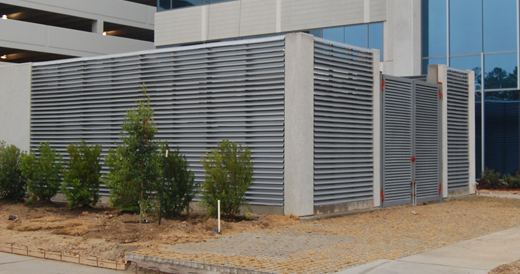
Equipment screens are built to surround heavy equipment mounted on the roof of a building. Passersby will only see the uniform lines of the equipment screen and not the HVAC unit concealed behind it. They are similar in design to vision screens, but their primary purpose is to conceal equipment.
You can also use vision screens to hide unsightly areas, such as the building's dumpster area. Create a gate system that blocks sight lines to the dumpster. Out of sight, out of mind! This is a common use for vision screens, but there are many more ways to utilize these versatile louvers.
Use vision and equipment screens to create restricted areas around your building or to cover roof-mounted HVAC equipment.
3.) Sunscreens
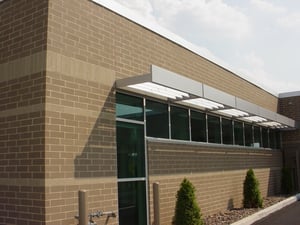 Sunscreens, or sunshades, are louvered panels mounted to hang over windows. These louvers mitigate the excess radiant heat caused by direct sunlight. Larger sunscreen panels will require support members to keep them in place.
Sunscreens, or sunshades, are louvered panels mounted to hang over windows. These louvers mitigate the excess radiant heat caused by direct sunlight. Larger sunscreen panels will require support members to keep them in place.
The sunscreen’s blades are angled to block sunlight as it passes over the window, providing shade during the hot seasons. Less direct sunlight means less heat radiating through your windows. Your interior spaces will remain cooler throughout the day and will require less energy to stay cool.
A well-placed sunscreen can also be used to heat your rooms during the cold seasons. At the right angle, the blades will allow sunlight through your windows. This provides a source of radiant heat during the winter. Proper installation will require understanding which sides of your building receive the most sunlight and knowing the solar angles during each season.
Sunscreens are a cheap and effective way to cut energy costs and maintain an efficient HVAC system. Learn more about selecting sunscreens for your project with "Sunscreens for Passive Cooling". And like any other louver, sunscreens are customizable to match your building’s aesthetic.
4.) Acoustical Louvers
Acoustical louvers deaden the noise of loud machinery by attenuating the sound waves that pass through. They achieve this with help of an insulated blade core and a perforated blade profile. Each acoustical blade has several holes along its surface, which trap air as it flows over the blade.
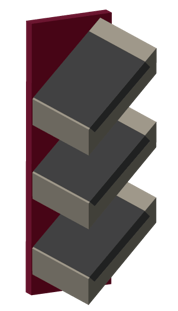
The trapped air passes over the insulation, which dampens the sound waves carried by the air. The remaining air flow that wasn’t trapped in these holes will pass through the blade and on through the duct. In this way, the acoustical blades dampen the noise.
They won't block all noise that passes through, but they do an excellent job of lowering the volume. Acoustical louvers can reduce sound transmission by 4 to 12 decibels, depending on the size of the louver.
These louvers are mounted in openings to rooms with loud machinery. Acoustical louvers perform the same functions as a standard louver, but at a loss of air performance. Their perforated blades work to attenuate noise, but they can also create more pressure drop as air passes through.
Acoustical louvers focus on dampening sounds at the source, so they don’t carry through the rest of the building.
5.) Thin Line - Architectural and PTAC
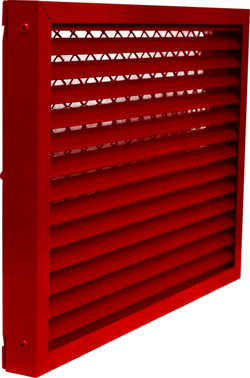 Sometimes, you might have a ventilation opening that leads to a small AC unit. And sometimes, you just want a nice louvered look on your building. In both cases, you don’t need a standard, full-sized louver. For these applications, you need architectural louvers and PTAC louvers.
Sometimes, you might have a ventilation opening that leads to a small AC unit. And sometimes, you just want a nice louvered look on your building. In both cases, you don’t need a standard, full-sized louver. For these applications, you need architectural louvers and PTAC louvers.
These louvers are commonly referred to as “thin line”, because they are less than an inch deep. Each louver type will serve a different purpose. Check out our article on architectural and PTAC louvers for a full breakdown.
Architectural louvers are decorative louvers used to accent and enhance architectural facades. They typically employ vertical blade supports instead of a frame. Architectural louvers create a louvered look along any architectural surface, without needing a large and cumbersome louver.
PTAC louvers are designed for small-scale ventilation, specifically for packaged terminal air conditioners (PTAC). Their thin design makes them the perfect option for covering the ventilation openings required for PTAC units. PTAC louvers will often be packaged with the PTAC unit, as part of a full assembly.
Architectural and PTAC louvers utilize the same design – the thin line louver – for different applications.
6.) Brick Vents
Brick vents are small, specialty louvers designed for openings in brick walls. Standard louvers can be mounted into masonry, but brick vents provide a cheap and effective solution for smaller applications.
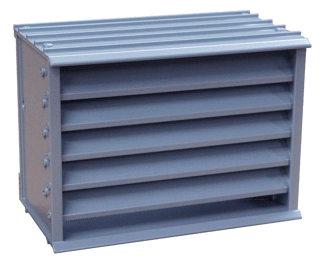
These louvers are designed to take the place of a few bricks in the wall, providing a small area for ventilation. Brick vents can be attached to duct work via a straight-on duct attachment or a z-shaped duct attachment, for ductwork running under or over the brick vent.
Brick vents provide ventilation into areas immediately below ground level, either with a straight duct or z-shaped duct attachment. They also provide the most total free area for their size, upwards of 50% of the vent’s total area.
Brick vents sport straight blades that provide basic protection without compromising air flow. These traits mean better overall air performance.
7.) Penthouses
 Let’s say you have a ventilation opening on your roof that faces straight up into the sky. A standard louver won’t work here. You need something with a roof. You need a penthouse. Penthouses are comprised of a roof and four walls, in a box-like shape that sits over the opening.
Let’s say you have a ventilation opening on your roof that faces straight up into the sky. A standard louver won’t work here. You need something with a roof. You need a penthouse. Penthouses are comprised of a roof and four walls, in a box-like shape that sits over the opening.
Each of these walls can be solid or louvered, depending on your application. Think of it like a four-sided louver for your roof, except that any side can also be a solid wall or a pop-out glass panel.
Penthouse assemblies are installed over rooftop openings to protect the ventilation point from rainfall and other unwanted elements. They can be configured for intake or exhaust applications, depending on the type and configuration of its walls.
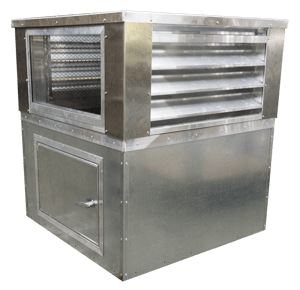 Penthouse louvers can be equipped with drainable louver panels for rainfall protection or non-drainable panels for air performance. They can have corners that are miter welded together or welded post style with reinforced metal covers.
Penthouse louvers can be equipped with drainable louver panels for rainfall protection or non-drainable panels for air performance. They can have corners that are miter welded together or welded post style with reinforced metal covers.
Penthouses will come with a throat attachment installed underneath the assembly. This attachment will sit inside the opening, much like a piece of ductwork. You can choose to mount a damper within the throat to control air flow through the penthouse opening.
With a combination fire-smoke damper, penthouses can be incorporated into a fire barrier and used as a smoke evacuation point. Penthouses are the versatile option for protecting rooftop openings.
As you can see, louvers can do more than just sit in a wall. There are other uses that you might not think of. Think about these specialty applications when you’re planning out your next project.
Can you think of other uses for louvers? Did we miss any specialty louver types? Tell us in the Comments section. We want to hear from you!
For more on louvers, check out these Newsstand articles:
- The Condenser - Style with Louvers
- Combination Stationary - Two-in-One Louver Solutions
- Three Common Types of Louvers
Do you have a question on something we haven't covered here? MCDLG can help. Contact us by clicking on the button below.
.webp?width=91&height=70&name=MCDLG%20Logo%20(Resize).webp)
.webp)





